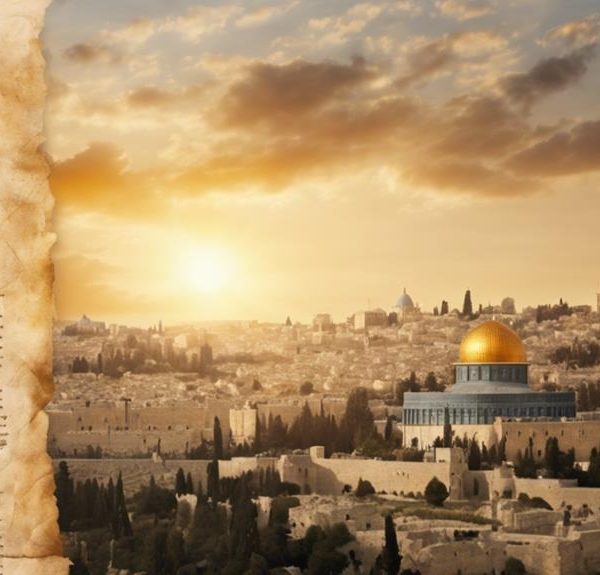Witness the profound messages of justice and morality in the Book of Amos, the intriguing sequel to Joel, and discover their timeless relevance.

Book After Joel in the Bible
Navigating from the cosmic upheaval in Joel, you'll stumble upon a treasure trove of ancient wisdom in the Book of Amos, which might as well contain the secrets of the universe.
As you explore its chapters, you'll uncover the relentless pursuit of social justice and divine wrath that Amos, a shepherd turned prophet, fervently preaches.
His visions and predictions not only shook the foundations of his time but also hold profound significance for modern readers.
If you've ever wondered how ancient texts still resonate in today's world, Amos's messages on equity and morality are a compelling place to start your journey into understanding.
Key Takeaways
- The Book after Joel in the Bible is Amos, addressing social injustices and divine accountability.
- Amos emphasizes the consequences of empty rituals and economic disparities.
- Themes of Amos include divine judgment through visions like the Locusts, Fire, and the Plumb Line.
- Amos's messages challenge readers to reflect on societal justice and personal morality.
The Prophet Amos: Background

Amos, a shepherd from Tekoa, emerges as a significant prophet in the Old Testament, advocating social justice amidst the affluence and idolatry of the Northern Kingdom of Israel. His background, deeply rooted in the pastoral lifestyle, significantly informs his prophetic message and method. As a shepherd, you can infer that Amos possessed a unique perspective on the societal dynamics of his time. This occupation, often overlooked in discussions of biblical figures, provided him with insights into the everyday struggles and injustices faced by the marginalized sectors of society.
His geographic origin, Tekoa, situates him approximately 10 miles south of Jerusalem, in the Southern Kingdom of Judah. Despite originating from the South, Amos's primary prophetic mission was to the Northern Kingdom of Israel, a testament to his extraordinary calling. Tekoa's location at the edge of the desert would have influenced Amos's worldview, embedding in him a stark awareness of vulnerability and survival, themes that resonate throughout his prophecies.
Understanding Amos's background—his occupation as a shepherd and his geographic origin—deepens your appreciation of his commitment to social justice. It underscores the profound connection between his pastoral life and his prophetic ministry, highlighting how his personal experiences shaped his messages of equity and divine accountability.
Themes in the Book of Amos

Delving into the Book of Amos, you'll uncover a rich tapestry of themes, from social justice to divine judgment, each intricately woven into the narrative to challenge the prevailing societal norms. Central to Amos's message are critical examinations of:
- Ritual Critique: Amos starkly criticizes the empty rituals and ceremonies that had become prevalent in Israelite worship. He argues that without justice and righteousness, these practices are meaningless to God. This theme underscores a profound critique of superficial religiosity, emphasizing that genuine faith must manifest in ethical living.
- Economic Disparity: The prophet vehemently addresses economic injustices and disparities, highlighting how the wealthy exploit the poor. Through vivid imagery and direct language, Amos exposes the greed and callousness of the elite, insisting that true prosperity can't come at the expense of the vulnerable.
- Divine Judgment: While not the primary focus of our discussion, it's crucial to acknowledge that the impending divine judgment serves as a backdrop to these themes, reinforcing the urgency of Amos's message. The prophet warns that unless society reforms, it will face catastrophic consequences.
These themes not only served as a rebuke in Amos's time but continue to challenge modern readers to reflect on issues of faith, justice, and societal responsibility.
Social Justice and Divine Wrath

Building on the critique of superficial religiosity and economic injustices, it's essential to explore how Amos intertwines social justice with divine wrath, emphasizing a holistic view of faith and morality. You'll find that Amos doesn't merely condemn the actions of the wealthy and powerful; he links their economic disparity and environmental neglect directly to the forthcoming divine retribution. This connection underscores a profound message: societal injustices and the degradation of the environment are not only moral failings but existential threats that invite divine judgment.
Aspect |
Implications |
|---|---|
Economic disparity |
Leads to societal instability and undermines the covenant relationship with God, highlighting the inherent value of every individual in the eyes of the divine. |
Environmental neglect |
Signifies a breach of stewardship over creation, reflecting a deeper spiritual malaise and a disregard for the sanctity of life and resources. |
Superficial religiosity |
Masks the underlying injustices, suggesting that true faith manifests in action towards equity and care for the earth. |
Divine wrath |
Serves as both a warning and a call to repentance, urging a return to genuine worship through justice and righteousness. |
Amos's message is clear: you're called to reflect on your faith through the lens of social justice and environmental stewardship, where failing in these arenas invites divine retribution.
Amos's Visions and Predictions

Turning our focus to the prophetic heart of Amos's message, we encounter a series of visions and predictions that starkly illuminate the consequences of Israel's moral and societal failings. Drawing from his shepherd origins, Amos employs agricultural metaphors to convey the impending doom awaiting the people of Israel if they don't amend their ways. His background not only informs his prophetic imagery but also grounds his message in a tangible reality that his audience, familiar with agrarian life, could readily understand.
The key visions and predictions include:
- The Locusts and the Fire: Symbolizing divine judgment, these images reflect the destruction that will consume Israel's harvest, a direct consequence of their ethical degradation.
- The Plumb Line: Representing the moral standards by which Israel is found wanting, this vision underscores the inevitable downfall due to their failure to uphold justice and righteousness.
- The Basket of Summer Fruit: Signifying the end of Israel as a prosperous nation, this metaphor paints a bleak picture of their future, devoid of blessings due to their persistent iniquity.
Through these visions, Amos articulates a clear and urgent call for repentance, leveraging his shepherd background to depict a nation at the brink of collapse unless it returns to the path of righteousness.
Significance for Modern Readers

Amos's prophecies, with their vivid agricultural metaphors and urgent calls for justice, hold profound relevance for contemporary readers, challenging us to reflect on societal and moral issues in our own times. The historical context of Amos, set in a period of social inequalities and religious decadence, mirrors today's global challenges, including economic disparity, environmental neglect, and the erosion of moral values. Through Amos, you're invited to explore how ancient warnings about greed, corruption, and indifference toward the poor have contemporary relevance.
Analyzing Amos's messages helps you understand the timeless nature of ethical conduct and social responsibility. His insistence on justice and righteousness transcends centuries, urging modern societies to evaluate their actions in light of these enduring principles. By engaging with Amos's text, you're not only delving into the historical context of his era but are also prompted to question how these lessons apply today. This scholarly exploration reveals that the book of Amos isn't just an ancient religious text; it's a compelling call to action, urging present-day readers to consider how they contribute to or combat societal injustices in their own lives.
Frequently Asked Questions
Who Wrote the Book That Comes After Joel in the Bible, and What Is Their Historical Context?
You're diving into a topic shrouded in authorship debates and date controversies. The writer of this mysterious text is enveloped in scholarly disputes. Historically, pinpointing their exact era is challenging, given the sparse direct references and varying scholarly interpretations.
This analysis uncovers layers of historical, cultural, and theological complexities. Understanding this author's context requires sifting through ancient narratives, archaeological evidence, and scholarly deductions, all while navigating the murky waters of biblical historiography.
How Does the Book Immediately Following Joel Compare and Contrast in Literary Style and Prophetic Message?
You're diving into how the next book contrasts with Joel in literary style and prophetic message. It leans more on apocalyptic imagery, presenting vivid, end-time visuals.
While Joel blends personal and communal repentance themes, this book broadens its scope with more universal themes, addressing a wider audience.
Its style, though equally poetic, adopts a more direct narrative approach to prophesy, diverging from Joel's more allegorical and interpretive method.
Are There Any Direct References or Allusions to the Book After Joel in the New Testament, and How Are They Interpreted?
You're looking at whether the New Testament contains references or allusions to a specific text, and how these are interpreted. In exploring New Testament citations, you'll find both direct quotations and nuanced allusions.
Interpretational variations among scholars are significant, often reflecting theological perspectives or historical contexts. Analyzing these references requires a detailed, scholarly approach, focusing not just on the occurrence of citations but also on their deeper meanings and implications within the New Testament narrative.
How Has the Book Following Joel Influenced Christian or Jewish Liturgy, Traditions, or Religious Practices?
You're exploring how liturgical and religious adaptations have been shaped by a significant text. This text's influence can be seen in various aspects of Christian and Jewish practices, deeply embedding itself into rituals and traditions.
Its narratives and teachings have prompted specific liturgical adaptations, enriching ceremonies and prayers. Moreover, religious practices have evolved, incorporating its themes and lessons, reflecting its enduring impact on faith communities.
This analysis highlights the text's profound effect on religious life.
What Archaeological or Historical Evidence Supports the Events or Prophecies Mentioned in the Book After Joel?
When you're examining archaeological or historical evidence for the events or prophecies, you'll find dating methods critical. These techniques, such as radiocarbon dating or dendrochronology, help establish timelines.
However, you must also tackle geographical inconsistencies that often arise in ancient texts. Careful analysis of artifacts, inscriptions, and settlement patterns can offer insights, yet the evidence mightn't always align neatly with the narratives or timelines proposed by these texts.
Conclusion
In conclusion, you've explored the profound depths of Amos, positioned right after Joel in the Bible. This exploration reveals Amos's critical role in emphasizing social justice and divine retribution. His vivid visions and stark predictions underscore a timeless message: societies must adhere to ethical standards and divine mandates to avert disaster.
For modern readers, Amos's writings offer a compelling call to action, urging a reevaluation of societal norms and personal ethics in light of ancient wisdom.



Sign up